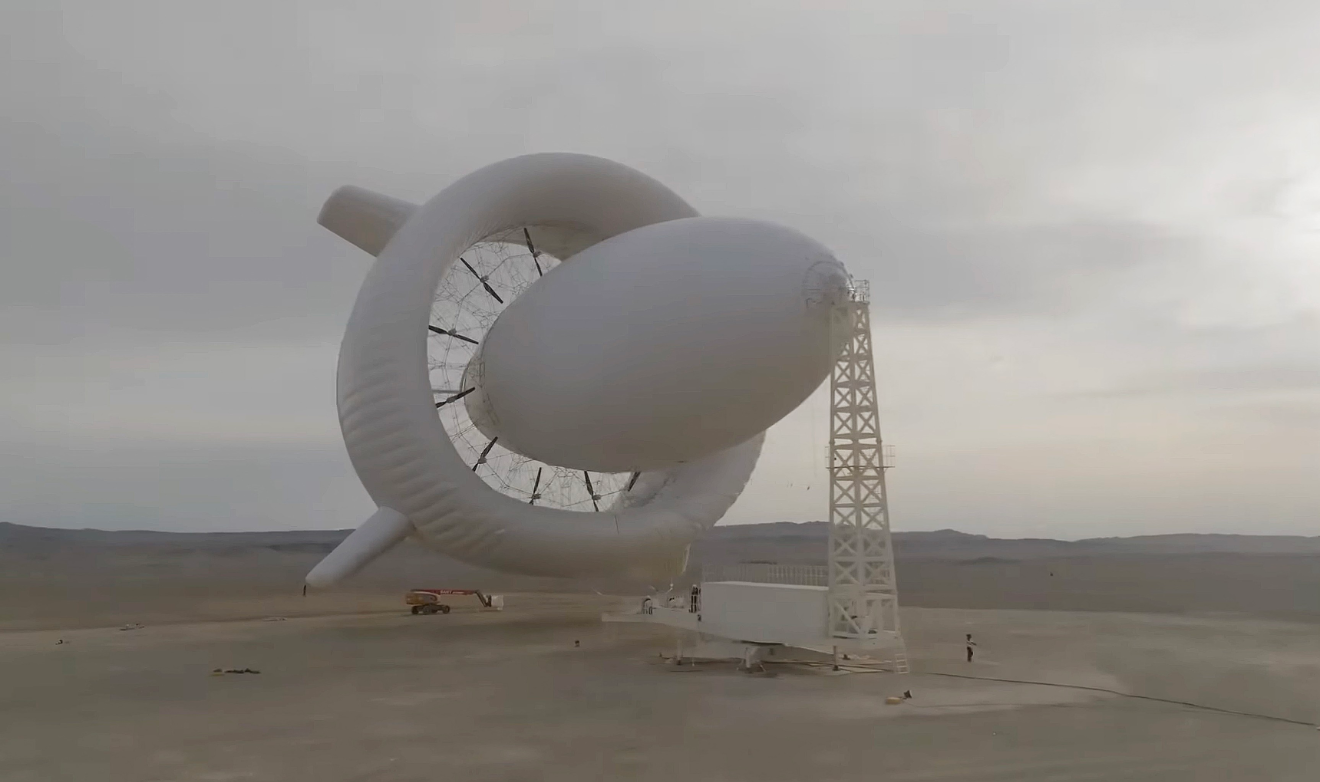Lifestyle
China Launches Groundbreaking Floating Wind Turbine to Harness Sky Energy

China has achieved a significant milestone in renewable energy by successfully completing the first flight of its domestically produced floating wind turbine, the S1500. This innovative system promises to reduce material consumption by 40 percent and lower electricity costs by 30 percent, while also minimizing its negative impact on the environment. The success of the S1500 marks a pivotal moment for the wind energy sector.
The S1500 is a commercial system with a capacity of one megawatt, designed to float in the sky like a giant airship. Measuring approximately 60 meters in length and 40 meters in both width and height, it stands as the largest wind generator ever constructed, according to data from Peking SAWES Energy Technology. Unlike traditional turbines that require a tower and deep foundation, the S1500’s design significantly reduces material usage, making it suitable for deployment in remote areas such as deserts, islands, and mining sites.
The floating turbine features a sophisticated aerodynamic profile and a ring-shaped wing that forms a giant channel. Inside this channel are twelve turbine-generator sets, each with a power output of 100 kilowatts. These rotors harness consistent winds at high altitudes, converting them into electricity, which is transmitted to the ground via a tethered cable.
Development of the S1500 was supported by Tsinghua University and the AIR (Institute of Aeronautical Research) at the Chinese Academy of Sciences. Researchers focused on achieving stability for the airship, creating ultra-lightweight generators, and developing high-voltage tethers that extend for kilometers, enabling the construction of large airborne wind farms.
The S1500 builds upon previous prototypes. In October 2024, the helium-filled dirigible S500 reached an altitude of approximately 500 meters in Hubei Province, generating over 50 kilowatts of power. Three months later, the S1000 ascended to around 1,000 meters, doubling its output to 100 kilowatts. These incremental advancements have validated the concept of harnessing energy at significant altitudes.
High-altitude winds, ranging from 500 to 10,000 meters above ground, are stronger and more stable than surface winds. This makes them a valuable resource for energy generation. Researcher Gong Zeci explained, “When wind speed doubles, the energy it carries increases eightfold; triple the speed and you have twenty-seven times more energy.” This exponential growth illustrates why turbines like the S1500 can produce far more energy than conventional land-based systems.
In addition to energy generation, these airborne turbines could serve as rapid-response platforms in the event of disasters. The system can be quickly deployed to areas affected by earthquakes or floods, providing power for lights, radios, and life-saving equipment. Veng Hanke, Chief Technology Officer of SAWES, emphasized the potential for air platforms to be launched swiftly after emergencies to maintain essential services.
By reducing reliance on traditional land-based turbines, airborne systems like the S1500 could unlock new energy sources in remote or difficult-to-access locations. Their mobility also makes them advantageous for temporary installations or emergency power supply. As China continues to innovate in the field of renewable energy, the S1500 represents a leap forward in harnessing the power of the skies.
-

 Health2 months ago
Health2 months agoNeurologist Warns Excessive Use of Supplements Can Harm Brain
-

 Health2 months ago
Health2 months agoFiona Phillips’ Husband Shares Heartfelt Update on Her Alzheimer’s Journey
-

 Science2 weeks ago
Science2 weeks agoBrian Cox Addresses Claims of Alien Probe in 3I/ATLAS Discovery
-

 Science2 weeks ago
Science2 weeks agoNASA Investigates Unusual Comet 3I/ATLAS; New Findings Emerge
-

 Science2 weeks ago
Science2 weeks agoScientists Examine 3I/ATLAS: Alien Artifact or Cosmic Oddity?
-

 Entertainment4 months ago
Entertainment4 months agoKerry Katona Discusses Future Baby Plans and Brian McFadden’s Wedding
-

 Science1 week ago
Science1 week agoNASA Investigates Speedy Object 3I/ATLAS, Sparking Speculation
-

 World2 months ago
World2 months agoCole Palmer’s Cryptic Message to Kobbie Mainoo Following Loan Talks
-

 Entertainment3 months ago
Entertainment3 months agoEmmerdale Faces Tension as Dylan and April’s Lives Hang in the Balance
-

 Science1 week ago
Science1 week agoNASA Scientists Explore Origins of 3I/ATLAS, a Fast-Moving Visitor
-

 Entertainment4 months ago
Entertainment4 months agoLove Island Star Toni Laite’s Mother Expresses Disappointment Over Coupling Decision
-

 Entertainment2 months ago
Entertainment2 months agoMajor Cast Changes at Coronation Street: Exits and Returns in 2025









